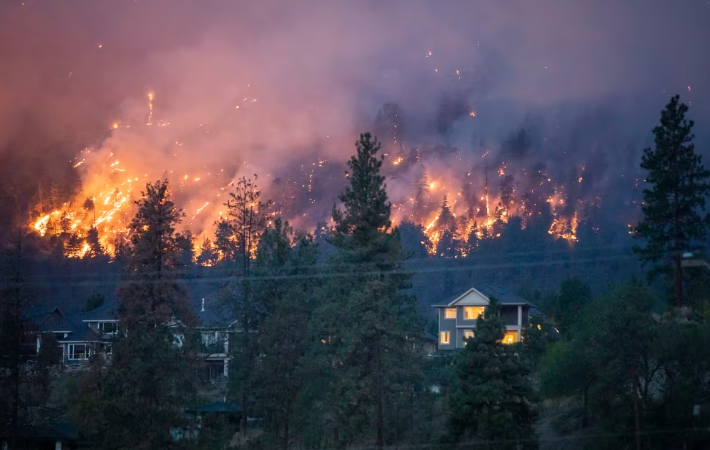Different cities, different wildfires: How 2 Canadian cities are fighting back

Firelines, sprinklers and water bombers: geography and weather play a role in how crews attack fires
Powerful wildfires are bearing down on Kelowna, B.C., and Yellowknife, but the two cities have different challenges, constraints and resources as firefighters take them on.
Weather, topography, water access and forest conditions are all influencing officials’ strategies to fight the flames in each location.
In Yellowknife’s case, fires have been burning near the territorial capital for weeks — since late June, according to the Natural Resources Canada.
A fire west of the city expanded and moved closer to the capital as winds picked up earlier this week.
Municipal workers and contractors have fortified the city’s western edge as a result.
Workers have dug a 10-kilometre fire line, and set up sprinklers and water canons along a 20-kilometre stretch, said Chris Greencorn, director of public works and engineering in Yellowknife.
“All in all, it’s likely the largest overland water distribution project that Yellowknife has ever seen, and this is our main line of defence,” he said.
But if the wind changes direction, it could still wreak havoc, Greencorn said.
“We’ve still got some really difficult days ahead,” he said.
“There’s no denying that.”
A spokesperson for the Department of National Defence told CBC News on Thursday that the Canadian Armed Forces has about 120 members deployed to the territory to help with wildfire efforts.
Officials issued an evacuation order earlier this week hoping to clear everyone out of Yellowknife by noon on Friday. Cat McGurk, a city councillor, has helped organize a team of volunteers working on the fire lines in recent days.
She said the community is accustomed to wildfires burning in the territory during the summer, given its placement in the middle of the boreal forest, but rallied together as the flames neared the city.
“Conditions changed and suddenly it became something we needed to address immediately,” she said in an interview with CBC News.
‘100 years worth of fire’
By contrast, the fire threatening B.C.’s Okanagan Valley intensified only days ago, on Tuesday. With hot, dry weather and winds gusting up to 50 km/h, the McDougall Creek wildfire spread quickly on the outskirts of Kelowna, B.C
Kelowna has a population of approximately 150,000.
The wildfire grew more than a hundredfold — from 64 hectares to 6,800 hectares (6.8 square kilometres) — in just 24 hours, causing damage in the nearby municipality of West Kelowna, officials said. West Kelowna is home to about 36,000 people.
“We fought hard last night to protect our community,” said West Kelowna Fire Chief Jason Brolund.
“We fought 100 years worth of fires all in one night.”
Environment Canada issued an updated special weather statement for the area on Friday warning of a risk of thunderstorms, dry lightning and “localized severe winds” potentially exceeding 70 km/h.
The airspace above Kelowna International Airport was closed early Friday to make room for aerial crews fighting the aggressive wildfires in the area in and around the city.
Cliff Chapman, director of operations for the BC Wildfire Service, said water bombers, helicopters and additional firefighters have been devoted to the fast-spreading fire.
Chapman said at some points on Thursday night the fire was spreading so quickly it was difficult to get resources and firefighters in place to take it on.
‘Building back better’
Gordon McBean, professor emeritus in the department of geography and environment at Western University in London, Ont., has been working with communities in an attempt to make them more resilient to wildfires and other extreme weather events.
“Although there are some communities they’ve done a good job in being, let’s say, building climate resilient communities, most of them haven’t,” he said.
“Most of them that did do it, did [so] because they had a disaster. And so after the fact, they rebuilt better — ‘build back better,’ as we say…. But it’s important that we also amplify the building now for the things that will happen in the future.”
Related News
Carney warns of ‘tough days ahead’ as tariffs make U.S. recession ‘likely’
Donald Trump’s latest round of tariffs is only a few days old, but the havocRead more
Top American scientists just lost their jobs. Canada is rolling out the welcome mat
Many top scientists in the U.S. are now out of a job. Health Secretary RobertRead more
